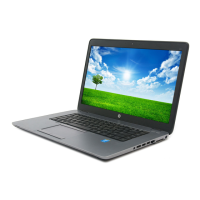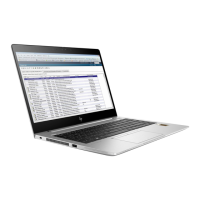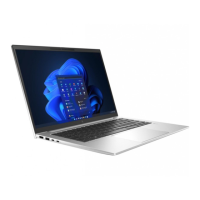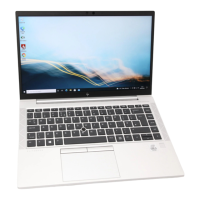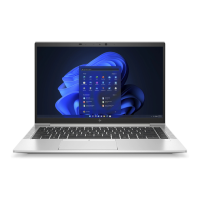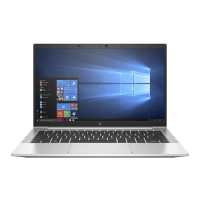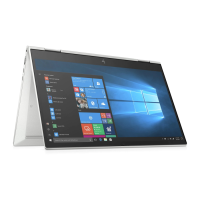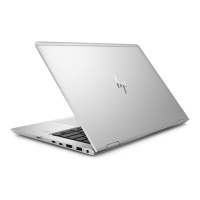Do you have a question about the HP EliteBook 840 G8 and is the answer not in the manual?
Identifies and describes components located on the right side of the computer.
Details the functionality of USB Type-C and Thunderbolt ports.
Explains the connection for video/audio devices via HDMI port.
Describes the battery status light and the power connector.
Identifies and describes components located on the left side of the computer.
Identifies and describes components related to the computer's display.
Introduces the keyboard layout and its variations by language.
Explains how to adjust touchpad settings and identifies its parts.
Details the specific parts of the touchpad and their functions.
Identifies and describes the various indicator lights on the computer.
Provides details on the function of each indicator light on the computer.
Locates and describes buttons, speakers, vents, and fingerprint reader.
Provides specific functions and operation details for buttons and fingerprint reader.
Identifies and explains the function of special keys on the keyboard.
Identifies and describes components located on the bottom of the computer.
Explains the purpose and location of various labels on the computer.
Step-by-step guide for inserting a nano SIM card.
Step-by-step guide for removing a nano SIM card.
Identifies major computer components with part numbers.
Lists and illustrates components that make up the display assembly.
Details the contents of the various cables included in the Cable Kit.
Lists the components included in the Bracket Kit.
Lists the components included in the Plastics Kit.
Lists various miscellaneous parts and their part numbers.
Lists the necessary tools for component removal and replacement.
Important points to consider during disassembly and assembly procedures.
Explains ESD and how to prevent damage to electronic components.
Precautions to protect electronic components from ESD damage.
Describes equipment and methods for personal grounding to prevent ESD.
Guidelines for preparing a safe, static-free work area.
Lists recommended items to prevent static electricity damage.
Procedures for safely packaging and transporting computer components.
Steps to take before disassembling the computer for self-repair.
Instructions for removing the computer's bottom cover.
Guides for removing and installing memory modules.
Instructions for removing the Wireless Local Area Network (WLAN) module.
Instructions for removing the Wireless Wide Area Network (WWAN) module.
Steps for removing the M.2 solid-state drive.
Steps to take before disassembly by an authorized service provider.
Instructions for safely removing the computer's battery.
Procedure for removing the Real-Time Clock (RTC) battery.
Instructions for removing the computer's speakers.
Steps for removing the card reader board.
Instructions for removing the power connector cable.
Steps for removing the USB board.
Instructions for removing the fingerprint reader board.
Steps for removing the computer's touchpad.
Instructions for removing the Near Field Communication (NFC) module.
Steps for removing the computer's fan assembly.
Instructions for removing the computer's heat sink.
Procedures for removing the main system board.
Steps for removing the computer's display assembly.
Instructions for removing the keyboard and top cover assembly.
Guide to navigating and using the computer's BIOS setup utility.
Steps to reset BIOS settings to their original factory defaults.
Information on how to check for and install BIOS updates.
How to find the current BIOS version installed on the computer.
How to modify the computer's boot sequence using the F9 prompt.
Options for configuring Trusted Platform Module (TPM) security settings.
Information on HP's BIOS protection technology.
Procedures for backing up data and creating system recovery media.
Tools and methods for system recovery and restoration.
How to use HP Sure Recover for OS and software restoration.
Guide to using the Windows-based hardware diagnostics tool.
Methods to launch the hardware diagnostics tool from various system locations.
Instructions for downloading the hardware diagnostics tool.
Guide to using the UEFI-based hardware diagnostics tool.
Procedure to launch the UEFI hardware diagnostics tool.
Customizing settings for remote hardware diagnostics via UEFI.
Details on dimensions, weight, power, and environmental operating conditions.
Specific technical details for the computer's display panel.
Technical specifications for various solid-state drive capacities.
Steps to restore nonvolatile memory to factory settings.
Troubleshooting steps for nonvolatile memory usage.
Frequently asked questions regarding nonvolatile memory and BIOS.
General power cord requirements applicable globally.
Specific power cord requirements based on country or region.
| RAM | Up to 64 GB DDR4-3200 SDRAM |
|---|---|
| Storage | Up to 2 TB PCIe NVMe SSD |
| Graphics | Intel Iris Xe Graphics |
| Battery | HP Long Life 3-cell, 53 Wh Li-ion |
| Wireless | Intel Wi-Fi 6 AX201 (2x2) and Bluetooth 5 combo |
| Bluetooth | Bluetooth 5 |
| Processor | 11th Generation Intel Core i5/i7 |
| Display | 14" diagonal, FHD (1920 x 1080) |
| Operating System | Windows 10 Pro |
| Ports | 2x Thunderbolt 4, 2x USB 3.1 Gen1, 1x HDMI 2.0, 1x headphone/microphone combo, 1x AC power |
| Webcam | 720p HD camera |
| Audio | Dual stereo speakers, dual array microphones |
| Security | HP Sure Start, HP Sure Sense, HP Sure Click |
